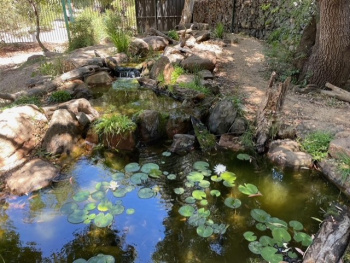
South Australian Science Teachers Association
Frog Ponds at Trinity Gardens School
Posted by SASTA
on 31/05/2022

In 2020 Trinity Gardens School proposed a redevelopment of our biodiversity area, beginning with our school frog pond.
Our existing ponds did not support ongoing aquatic animal lifecycles due to the toxicity of stagnant water, duckweed and algae. The current ponds were re-designed to encourage the necessary environment for tadpoles & frogs to thrive or frogs to be released in the area and continue to thrive. This included a clean-up of the ponds, creating pathways, planting native shrubs, creepers and grasses around the edges and introducing lilies to the pond.
Our aim was to create an authentic learning space that can be utilised and accessed by all facets of our school community which includes both Mainstream & Steiner education, an Early Learning Centre and the St Morris Unit which supports students with disabilities. The science classes utilise this space and students have built insect hotels and frog houses to encourage frogs and insects to visit the area.
|
Before |
After |
Pathways were developed around the pond edges and throughout the biodiversity area to enable safe access for students to the pond area. We are continuing to develop the area with bush tucker plantings to enable student learning and also establishing a variety of native plants to attract birds, butterflies and bees. Some of the plantings so far include Atherton Raspberries, an Appleberry, Davidson Plum, Boobialla, Sea Celery, River Mint, Pig Face, Native Thyme and Yam Daisies. We’re looking forward to seeing how the space thrives in Spring!

The bees have already made a home for themselves on an existing possum house.
This new biodiversity area can now provide authentic learning experiences and support the ongoing lifecycles of aquatic animal life and will soon attract birds, butterflies and bees.
- Meridee McClean
Archive
- April 2024
- March 2024
- February 2024
- December 2023
- November 2023
- October 2023
- September 2023
- August 2023
- July 2023
- June 2023
- May 2023
- April 2023
- March 2023
- February 2023
- January 2023
- December 2022
- November 2022
- October 2022
- September 2022
- August 2022
- July 2022
- June 2022
- May 2022
- April 2022
- March 2022
- February 2022
- January 2022
- December 2021
- November 2021
- October 2021
- September 2021
- August 2021
- July 2021
- June 2021
- May 2021
- April 2021
- March 2021
- February 2021
- January 2021
- December 2020
- November 2020
- October 2020
- September 2020
- August 2020
- July 2020
- June 2020
- May 2020
- April 2020
- October 2018
- September 2018
- August 2018
- July 2018


